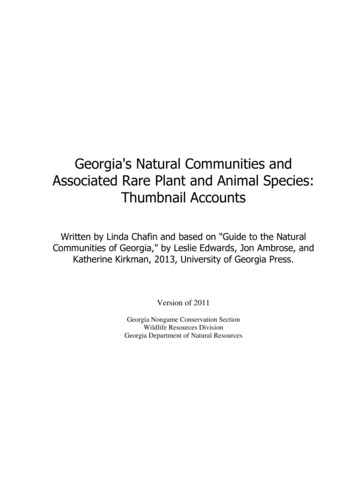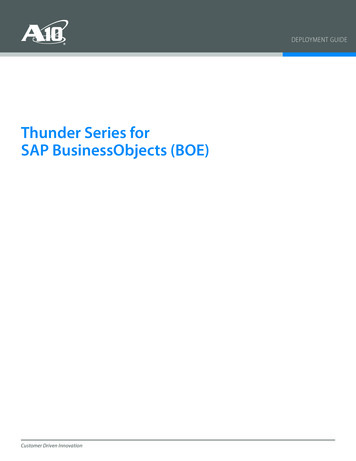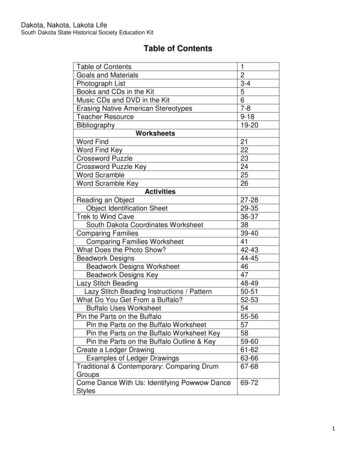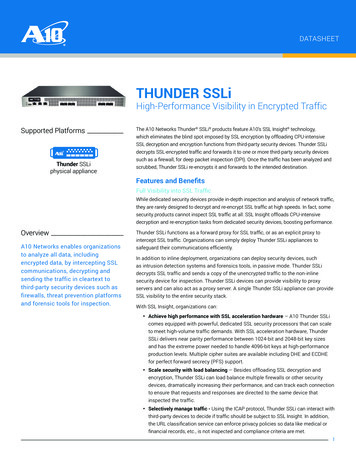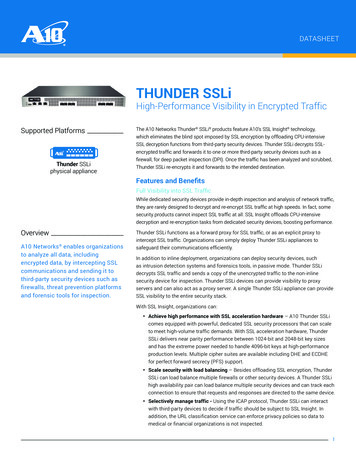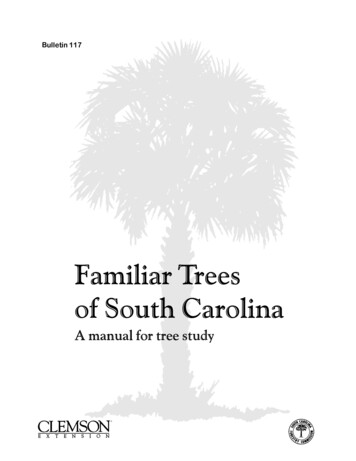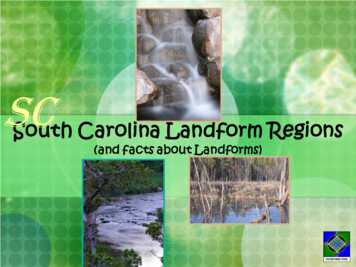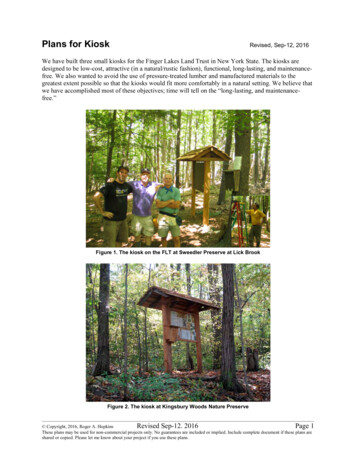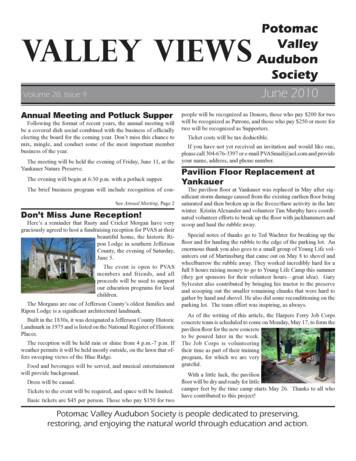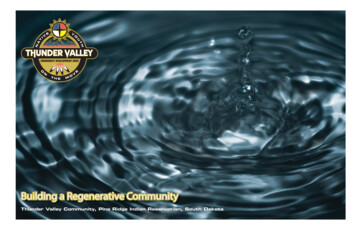
Transcription
Building a Regenerative CommunityThunder Valley Community, Pine Ridge Indian Reservation, South Dakota
2THUNDER VALLEY - BUILDING A REGENERATIVE COMMUNITYW O P I L A T H A N K YO UThis report synthesizes the outcomes of a workshop held in Porcupine, South Dakota onMay 13 and 14, 2013. Thunder Valley CDC, organized this workshop to bring community members andpartners together to consider the next steps for regenerative community development on a 34-acre parcelof land just north of Sharps Corner in the Porcupine District of Pine Ridge Indian Reservation.Sincere thanks goes out to the following individuals who attended this workshop to give their knowledgeand support to this transformational project (listed alphabetically):Mike BenderMitch BennetSteve BloserDave ConineSharice DavidesKim DrennanRobert EcoffeyTonia EcoffeyRosemary FagreliusDana ForemanEugene GonzalesGilda HaasJosh HembergerEd Iron CloudAndy Iron ShellTerrell Iron ShellIn partnership withJennifer IrvingTom IschkumRoger JacobsRyan KeanBarb LebeauJerome LebeauNick LivermontWilliam LockeLenny Lone HillMatt MartinShane MartinezJohn McDonaldDavid MixChris O’HaraTim PottsRob PyattKeegan RaleighSangaJody Sarkozy-BanoczyJames SchaefferCraig ScrantonDavid ShearerChristine SorensenRob StreckerMark TilsenJason TinantBill VanderwallScott WestonDavid ZereMarie ZereBill ZieglerSpecial Thanks to our National Advisory Board members:Rebecca Adamson, President & Founder, Indigenous Economist, First Peoples WorldwideBob Berkebile, Principal, BNIM Architects & PlannersRosemary Fagrelius, Minnesota Housing Partnership, Housing Development DirectorGilda Haas, Faculty, Antioch UniversityRussell D. Kaney, Director, Programs, National Rural & Native American Initiative, Enterprise CommunityPartners, Inc.Jim King, President, Fahe Inc.Chrystel Cornelius, Executive Director, First Nations Oweesta CorporationDavid Bland, Chairman & CEO, Travois Inc.Lisa Richter, Founder and Principle, GPS Capital Partners
TABLE OF CONTENTSTA B L E O F CO N T E N T SIntroduction and Background. . . . . . . . . . . . . . . . . . . . . . . . . . . . . . . . . . . . . . . . . . . 4Master Plan . . . . . . . . . . . . . . . . . . . . . . . . . . . . . . . . . . . . . . . . . . . . . . . . . . . . . . . . . . . . 8Renewable Energy System . . . . . . . . . . . . . . . . . . . . . . . . . . . . . . . . . . . . . . . . . . . . . 12Stormwater System. . . . . . . . . . . . . . . . . . . . . . . . . . . . . . . . . . . . . . . . . . . . . . . . . . . . 14Potable Water System. . . . . . . . . . . . . . . . . . . . . . . . . . . . . . . . . . . . . . . . . . . . . . . . . . 16Water Treatment and Reuse System . . . . . . . . . . . . . . . . . . . . . . . . . . . . . . . . . . . . 18Next Steps . . . . . . . . . . . . . . . . . . . . . . . . . . . . . . . . . . . . . . . . . . . . . . . . . . . . . . . . . . . . 223
4THUNDER VALLEY - BUILDING A REGENERATIVE COMMUNITYA B O U T T H U N D E R VA L L E YThunder Valley is located in the northern part of the Pine Ridge Indian Reservation, Oglala Lakota Nation between SharpsCorner and Rockyford. The heart of this winding valley was formed over thousands of years as Porcupine Creek carvedits way through the grass-covered hills at the edge of the badlands of South Dakota. It was long ago in this region thatthe Lakota people originated, having spread out and flourished in the 18th and 19th centuries. The origins of the nameThunder Valley have long been forgotten, and until recently only the elders and old ranchers still used the name. Now thename is synonymous with an amazing renaissance of traditional values and cultural pride.In 1998 the rebirth of the ancient rite of traditional Lakota Sun Dance was reintroduced in the Thunder Valley community.This celebration of sacrifice, life and rebirth laid the foundation for change, offering culture, tradition, and a renewed senseof responsibility toward family and community. As this circle of change grows larger with each passing season, more andmore individuals and families have become involved creating the energy and passion needed to set a powerful path forward.The Thunder Valley Community Development Corporation was created in 2007 using this same energy of resiliency andcommunity values. Nurtured from conversations voiced by youth to elders who realized we honor the best of our past byutilizing new tools, new ideas and new strategies as we create the opportunities of the future, Thunder Valley CDC cameinto being.Thunder Valley Community Development Corporation (CDC) is a Oglala-led, Native American 501(c)3 non-profit publiccharitable organization based out of the Thunder Valley community of the Porcupine District on the Pine Ridge IndianReservation. Our mission is empowering Lakota youth and families to improve the health, culture, and environment of ourcommunities, through the healing and strengthening of cultural identity.A C A L L TO A C T I O NOur Mission:Empowering Lakota youth and families to improve the health,culture and environment of our communities, through thehealing and strengthening of cultural identity.Thunder Valley CDC was inspired by the Lakota way of life. It is part of a generation of young Lakota people who have begun to reconnect and reclaim our Lakota cultural and spiritual identity. Through building a foundation of cultural identity,a sense of responsibility for the current and future generations has been instilled in us. We honor our elders and ancestors that have come before us and fought for our way life, held on to our lands, and built the very foundation we stand ontoday.Thunder Valley CDC looks out into our communities and we see our people in struggle. We see the harsh impacts ofpoverty, lack of housing, lack of jobs, poor education and many who have lost hope. Our work is dedicated to changingthat struggle and making a difference. Our approach is from the bottom up not from top down. We strongly believe thatthe solutions for changing our communities on Pine Ridge are here, amongst the people, in our spirits, in our innovations,prayer, creativity and hard work.
INTRODUCTION AND SECTIONBACKGROUNDTITLEPLANNING FOR A BET TER FUTUREBeginning in 2010, Thunder Valley CDC coordinated a regional planning process for the Oglala Lakota Nation on PineRidge Indian Reservation through the inaugural grant of the Department of Housing and Urban Development (HUD) Sustainable Communities Regional Planning Program. This regional plan is called Oyate Omniciye Oglala Lakota Plan, andhas been adopted by two successive tribal councils at this time.Oyate Omniciye began with conversations involving a small circle of Lakota elders who talked about what Lakota peopledo when getting together to “plan” for something important. During conversation, a dialogue emerged about whetherthe Lakota language had a word for “sustainability”. Ultimately, the group came to the simple words: Oyate Omniciye –Roughly translated, “The Circle Meetings of the People”. The phrase carries deeper meanings. First, “Oyate” refers not onlyto humans, but to all living beings. Secondly, calling for an “Omniciye” is not to be taken lightly. This word signifies thatvery important things are to be considered, and in the way of the Lakota, the ultimate goal is to seek consensus for all whowished to remain in the conversation. The goal was to create a Regional Plan, developed through communication andpartnerships of those living and working within this ‘Region,’ which encompasses the boundaries and jurisdiction of theOglala Lakota Nation.Thunder Valley CDC facilitated community conversations. These conversations included input from children, elders,elected officials, community leaders, all those vested in building a healthy and sustainable tribal community. This collaboration of committed citizens, organizations, tribal and outside agencies took an in-depth look at existing systems thataffect everyday lives of those living on the Pine Ridge Indian Reservation. An honest and collaborative conversation aboutthe challenges our tribal communities face and what lies in the future, was made possible by information gathering andcommunity outreach.The overarching objectives in this regional sustainability plan for the Oglala Lakota are to: Continue the healing and strengthening of our people by bolstering identity and opportunity through the unique andbeautiful perspective of Lakota knowledge, culture, and language.Reinvigorate a thriving, dynamic, and robust society where all share in the benefits.Honor our connections with the Earth and seek out ways to protect her environment.Create meaningful economic and job opportunities that reignite cultural identity.Promote and enhance public health, and awareness of healthy alternatives.Provide and enhance infrastructure, housing, and social services at an affordable cost.From broad public engagement and professional analysis during this two-year planning process, twelve interrelated initiatives emerged that hold the greatest potential for achieving the objectives above. One of the first of these initiatives tomove forward to implementation is an effort that supports and integrates many of the goals of the Oyate Omnicye plan:the development of a Model Community in Thunder Valley.“How long are you going to let other people decidethe future for your children? Are you not warriors?Don’t come from a place of fear, come from a placeof hope. Start talking and start doing!”5
6THUNDER VALLEY - BUILDING A REGENERATIVE COMMUNITY48%250070%60%1/448 523OF RESIDENTS ON THE RESERVATIONLIVE BELOW THE POVERTY LINE.LOW INCOME FAMILIES WITHUNMET HOUSING NEEDS. 70%OF ALL HOUSEHOLDS ELIGIBLEFOR HOUSING SERVICES.OF ALL HOUSING ON THERESERVATION IS HUD HOUSING ORA TRAILER HOME. MOLD HAS BEENFOUND IN 75% OF HOUSING UNITS.OF THOSE WHO LIVE ON THERESERVATION WORK SOMEWHEREELSE, AND 56% TRAVEL MORETHAN 50 MILES TO WORK.THE SALES VOLUME ANDTHE NUMBER OF JOBS ANDBUSINESSES PER CAPITA ONTHE RESERVATION COMPAREDTO THE SURROUNDING REGION.IS THE LIFE EXPECTANCY OF MENAND WOMEN RESPECTIVELY ON THERESERVATION - ONE OF THE LOWESTIN THE WESTERN HEMISPHERE.TIMES HIGHER GROWTH RATEON THE RESERVATION THANTHE REST OF SOUTH DAKOTA.A N E W A P P R O A C H TO S Y S T E M I C C H A L L E N G E SThe goal of the Thunder Valley Regenerative Community is to create a sustainable and interconnected community thatprovides better housing, places for business to thrive and a healthy supportive environment for youth, elderly and families. The community is envisioned as a living laboratory to build skills, knowledge and capacity for residents. This projectwill explore and refine new ways of living that build on traditional Lakota values to develop innovative, homegrown Nativesolutions to a variety of challenges.While many other rural areas in the Great Plains are facing stagnant growth, the population at the Pine Ridge IndianReservation is growing significantly. Even though Census figures are widely understood to undercount population onthe Reservation, they still show a growth rate of more than 21% between 2000 and 2010 - nearly three times the growthrate of South Dakota. More than half of Pine Ridge residents are under the age of 25. This population growth underpins anexisting and growing demand for housing and services on the Reservation.However, the construction of new housing has not kept pace with the increasing need. Land fractionation, complicatedproperty ownership, lack of available land, and limited access to financing all present barriers to the construction of newhousing. In addition to financial and regulatory obstacles, affordability is a factor that limits access to quality housing formany. The median household income on the Pine Ridge Indian Reservation is 27,065, compared to the state median income of 46,3691. About 48% of residents on the Reservation live below the poverty line. These low incomes severely limitthe availability and quality of housing for Pine Ridge residents. Out of approximately 4,700 total households,3,300 (70%) are eligible for Oglala Sioux Lakota Housing services, which estimates that there are unmet housing needs formore than 2,500 low-income families.Lack of supply and low incomes contribute to overcrowding, low quality construction, and poor housing conditions. Theaverage household size on the reservation is between 6.7 and 9.2 persons, compared to a national average of 2.6 personsper household. While this reflects to some degree differences in Native family structures, it is also an indication of overcrowding. Homes without adequate plumbing or kitchen facilities are often used as an indicator of inadequate housingconditions. On the Reservation, 9% of units lack adequate plumbing and 8% lack kitchen facilities; the national averagefor these condition are .5% and .8% respectively. Beyond physical housing conditions, many families face difficult homeenvironments (suicide rates that are five times the national average highlight the severity of these challenges).Compounding challenges from a lack of housing and poor housing conditions, the scattered patterns of housing developments make it difficult to provide basic infrastructure to many homes. Through transportation costs, water quality, airquality, and more, current housing development patters reduce the health, freedom, and prosperity of our people. Toooften, existing housing clusters have become sources of crime and violence.The Thunder Valley Regenerative Community begins to address community needs by providing more housing that is highquality and affordable, exploring creative approaches to overcome financial and regulatory barriers, and creating healthy,supportive living environments. However, the Thunder Valley Regenerative Community is also about more than housing.This project provides an opportunity to create a sustainable and interconnected community where there are educationand workforce development opportunities, places for businesses to thrive, and places for youth to participate in healthy,safe activities. Thunder Valley Regenerative Community can also function as a “living laboratory” that explores and refinesnew ways of living and replicable models to address a variety of needs throughout the Reservation. While this project isnot the entirety of the solution for housing needs on the Reservation, it can simultaneously provide housing and services,while building skills, knowledge, and capacity to tackle housing challenges on a wider scale.
INTRODUCTION AND SECTIONBACKGROUNDTITLEA R E G E N E R AT I V E CO M M U N I T YThe site of the future planned community is located ¼ mile northof Sharps Corner, in the Porcupine District. The project is drivenby the need for jobs, housing, facilities, and new opportunitiesthat don’t currently exist on the Reservation, and emphasizes theneed to create new systems that foster and bolster social changethrough action and sustainable development. The proposeddevelopment is located on fee-simple, deeded land, which willhelp enable it to secure financing more easily than tribal land.On May 13 and 14, 2013, Thunder Valley CDC hosted aworkshop to bring all of the partners together to discuss thepopulation, density and locations of land uses, building typesand infrastructure based on the objectives of the community toprovide affordable, efficient homes, produce all energy on site,clean all waste water on site, and create a new high performanceLakota-grown economy. Several presentations were given toinform the work of the group including the presentation of aframework to evaluate alternative energy production and waterreuse on the site to establish an overall live/work populationgoal; a presentation on housing studies including applicablefinancing mechanisms and the draft business plan for propertymanagement by Thunder Valley CDC; and finally a presentation onroads, soil conditions and tire baling applications. The followingsections of this document represent the collective vision of thecommunity for the design, development, performance, andmission of a regenerative community at Thunder Valley.93JOBS CREATED ON THE RESERVATIONFROM NEW CONSTRUCTION.5824IN ANNUAL FUEL COST SAVINGSFOR EACH RESIDENT WHO DOESNOT NEED TO COMMUTE TO ORFROM RAPID CITY DAILY.7CO O R D I N AT I N G I N I T I AT I V E SSustainable Housing Research Project:Through a partnership with the Native American Sustainable Housing Initiative,University of Colorado Boulder, Oglala Lakota College, and the South DakotaSchool of Mines and Technology, Thunder valley will complete a straw baledemonstration house and begin construction of a Structured Insulated PanelDemonstration House.Workforce Development Through Sustainable Green Home Construction:Open to all ages and educational backgrounds, this program teaches life skills andleadership development tools to provide financial literacy, debt education, andbasic life planning. This program also includes occupational construction skills inan on-the-job training program where participants will be actively building greensustainable homes within the development of Thunder Valley.Youth Build - Department of Labor Program:This program provides classroom instruction and occupational skills trainingto at-risk individuals aged 16-24. Participants learn valuable skills as they buildaffordable housing for low-income or homeless individuals and families intheir communities. Non-construction skills training will also include leadershipdevelopment and community service elements to ensure that youth maintain aconnection to their communities through service and volunteerismSelf-Help USDA Housing Program:The Mutual Self-Help Housing Program makes homes affordable by enablingfuture homeowners to work on homes themselves. With investment of “sweatequity,” each homeowner pays less for his or her home than if it were built by acontractor, providing low income families an opportunity to own their home.Sustainable Home Ownership Project:Thunder Valley is playing a lead role in the creation of the Sustainable HomeOwnership Project (SHOP). This program will help families prepare and readyfor Home Ownership on the Pine Ridge Indian Reservation. This is partnershipwith Thunder Valley CDC, Mazaska Oweecseo Otipi Financial, OST Partnershipfor Housing, The Lakota Funds, The Lakota Federal Credit Union and Oglala SiouxLakota Housing.Worker-Owned Construction Company:Thunder Valley is exploring the creation of a worker owned construction-companyto build parts of the development and compete regionally in the constructionindustry. In 2014 Thunder Valley CDC will do a market study, feasibility study thatwill inform the decision to move forward with the creation of the company as acommunity asset and wealth creation model.Community Food Systems Strategy:In 2014, Thunder Valley CDC is pursuing resources to look at a community foodsystems strategy for the region to address food security and food sovereigntyissues. This research will directly inform a strategy to create a better food systemfor the Pine Ridge Indian Reservation which could result in a grocery store, fooddistribution center, a food hub, commercial green house, or other projects withinthe development at Thunder Valley.20100%060%98%AT-RISK STUDENTS BUILDING 5HOMES THROUGH THE DEPARTMENTOF LABOR’S YOUTH BUILD PROGRAM.OF IRRIGATION PROVIDED BY ON-SITEECOLOGICAL WATER TREATMENT,RESTORING SURPLUS TO AQUIFERINCREASE IN STORMWATERRUNOFF AT FULL BUILD-OUT.REDUCTION IN BASELINEENERGY USE.OF ENERGY NEEDS PROVIDEDBY RENEWABLE SOURCES.
8THUNDER VALLEY - BUILDING A REGENERATIVE COMMUNITYT H U N D E R VA L L E Y M A S T E R P L A N1112109843THUNDER VALLEYCULTURAL ARTCENTER25EDUCATION ADMINCENTER OFFICES8FITNESSDAY 00’N191234567891011121314151617181920Empowerment Center (55,000 sf, 1.5 stories)Central Plaza / Market (100’ x 250’)Visitor Parking / Bus Drop-offBusiness Incubator / Retail / Apartments (40,000 sf, 2-stories)PowWow Grounds (100’ diameter)Youth ShelterSkateboard Park / Ropes CourseStudio Space / Apartments (1 @ 30,000 sf, 1 @ 18,000 sf, 2-stories)General Parking (50 stalls)Light Industrial (30,000 sf, 1-story)Loading Dock Area (160’ x 190’)Flex Space / Office Space / Retail (30,000 sf, 1-story)Townhouses (3 @ 10,000 sf, 8 units per building, 24 units total)Outdoor Basketball CourtSingle Family Housing (27)Co-housing Cluster (equivalent to 4 single family houses)Aquaponics Greenhouses (2 @ 6,000 sf ea.)Outdoor Garden (15,000 sf )Bunkhouses (1,600 sf, 3 buildings)Spiritual Spaces / Traditional Medicinal Plants
MASTER PLANSECTIONTITLEThe power of a master plan is to communicate the whole vision for a place. The master plan for Thunder ValleyRegenerative Community provides the holistically conceived framework to achieve implementation of sustainableinfrastructure, homes, and commercial buildings. The organization is informed by the topography of the land, waterflow, and integration of culturally important spaces for a thriving Lakota community.The capacity-building inputs and outputs explored at the two-day workshop in May 2013 resulted in the masterplan shown here. The master plan illustrates the adjacent land uses and movement through the site by foot, bike, orvehicle. The hub of the community is the Empowerment Center. This mixed use building has flexible spaces for lifelong education programs and workforce training, meeting space, administrative offices for Thunder Valley CDC, aCultural Arts Center, a daycare for children of families working in this development, and health and fitness facilitiesincluding flexible space for a clinic to operate on some days. This is where a visitor comes first to learn about ThunderValley and the Lakota culture. The Cultural Arts Center will tell the story of the Lakota Nation and showcase the talentof local artists, past and present. Adjacent parking will be convenient to this central building, but will also be bufferedby plantings to mediate the pollution from the road and collect stormwater runoff from the roads and parking area.This main entrance also leads directly to the youth shelter, temporary housing for the most vulnerable in Thunder ValleyCDC’s mission to address social, economic and cultural issues facing native youth.The Empowerment Center is part of a cluster of buildings centered on Pow Wow grounds. Just north of theEmpowerment Center is an open air market space, and a mixed use two-story building programmed for businessincubation, private offices, and retail shops on the ground floor with apartments above. To the west of the Pow Wowcircle are two two-story buildings that will function as artist studio spaces and apartments. The areas south and westof these buildings include a skatepark, a ropes course, walking paths and gardens with edible plants and traditionalmedicinal plants to create spaces for relaxation, exercise, meditation, worship, community gathering, and outdoorclassroooms or studios.The north part of the site is dedicated to commercial uses, both light industrial, and flexible office and retail space. Widerroads of higher compaction strength are designed for this area to allow for large delivery trucks. During the constructionphases, materials and staging would be coordinated here.The south part of the site is primarily residential and demonstrates several types of housing including a high efficiencysingle family type, attached townhomes, a co-housing cluster of single family homes in close proximity for extendedfamily, and a bunkhouse for visiting volunteers and students. This area provides permanent housing for 55 households.The apartments and studio spaces on the north part of the site provide space for approximately 60 more households tolive and work on site.Lastly, the aquaponics greenhouses and large community garden are located on the south, and lowest, part of the site.These facilities serve the health and well-being of all who come to live, work, and learn in this environment.The following illustrations show two views of the development to further describe the spaces and activities occurringthere. The next sections of this document describe some of the layers of performance and preliminary engineeringanalysis of this development.Images of example programs (top to bottom):Skatepark; High performance construction and training programs;Pow Wow groundsImages of example programs (top to bottom):Aquaponics high tunnel; Artist studio space; Business incubator9
10THUNDER VALLEY - BUILDING A REGENERATIVE COMMUNITYOUTDOOR MARKETGYMNASIUMYOUTH SHELTERThis large outdoor space is located between the EmpowermentCenter and Business Incubator. The space provides residencewith a large outdoor flexible space but also allows for a spacefor tourists to shop for goods produced by local artisansIndoor basketball court, doubles as a stormshelter. This facility is connected to theEmpowerment Center / Fitness Center.Adjacent to many of the activities available atThunder Valley, the facility provides youth guestrooms and counseling servicesSKATE PARKBASKETBALL COURTEMPOWERMENT CENTERThis canopy produces energy in addition to creatinga shaded outdoor spaceROPES COURSEThis facility houses cultural and community services.This conceptual illustration shows the heart of Thunder Valley.The Empowerment Center and surrounding market, powwowgrounds, and studio space create a cultural and communitycenter.SOLAR PANEL GATEWAYTRADITIONAL POW WOWGROUNDS ARBORPOWWOW GROUNDSLocated along the central green spaceARTIST STUDIOS AND LOFTSLower floor opens out onto the central greenand provides flexible space for artists and otheractivities. Second level has apartments.
MASTER PLANSECTIONTITLESINGLE FAMILY RESIDENCEArranged on quarter acre lots, this developmentcomposition allows for shared outdoor space,gardening, and the development of a trail systemSPIRITUAL SPACETucked behind the ridge line from the main developmentarea, this space will provide a more secluded space fortraditional ceremonies and medicinal plant cultivationThis conceptual illustration shows a view of the residentialarea. The view is centered on the main green shared spaceand highlights the many community uses in that space andsurrounding buildings. The surrounding structures showcasethe range of residential options available on site.CO-HOUSING MODELYOUTH SHELTERGYMNASIUMThis housing model consists of a cluster of singlefamily residences spaced closer together in a halfmoon. The form is traditional to the Lakota peopleand offers a protected shared space and strongersense of communityAdjacent to many of the activities available atThunder Valley, this facility provides youth guestrooms and counseling servicesThis Indoor basketball court, doubles as astorm shelter, and this facility is connectedto the Empowerment Center / FitnessCenter.ROPES COURSEBASKETBALL COURTWIND TURBINECENTRAL GREEN CAMPING SITEDAY CARE FACILITYConnected to the Empowerment Center andadjacent to the outdoor playground, this facilityis located to provide easy drop off and pick upARTIST STUDIOS AND LOFTSTOWNHOUSESThe lower floor opens out onto the central greenand provides flexible space for artists and otheractivities, and the second level has apartments.These units are of similar size to single family housesand each have their own front door. These units willprovide a less expensive option for ownership.BUNK HOUSECOMMUNITY KITCHENAvailable to visitors and volunteers ofThunder Valley. This building housestwo sleeping quarters and a showerhouseCentrally located in the residential area, this facilityprovides a large gathering place for communitymembers to eat together and host celebrationsGARDENAQUAPONICS GREENHOUSEAquaponics is a method of food production whichcombines raising fish with growing vegetables. Thismethod produces the greatest amount of food in thesmallest footprint and each waste product fuels aneeded input, creating a harmonious system11
12THUNDER VALLEY - BUILDING A REGENERATIVE COMMUNITYIDL GRICACTRELER E N E WA B L E E N E R G Y S Y S T E MTotal Development Energy Use 8,524,000 kBTU(assumes 60% reduction from typical baseline)Total Development Renewable Energy Supply 8,410,580 kBTU(from solar arrays and one 100 kW wind turbine)23EXISTING ELECTRIC GRID (OVERHEAD)LOCAL UTILITY GRID (BURIED)ROOF MOUNTED SOLAR ARRAY112344SWITCHING STATION AND DEVELOPMENT METERSOLAR PANEL “GATEWAY”WIND TURBINEINDIVIDUALLY SUB-METERED HOUSING, TYPICAL
ENERGYSECTIONTITLE13In considering the balance of energy needs, it is a priority of Thunder Valley CDC to be able to produce all energyneeded on the site. This plan shows how 98% of this need is met through roof-mounted solar panels on each buildingand one wind turbine in its optimal location at the top of the hill. More solar panels could be added over the parkingareas and some of the larger buildings may benefit from roof mounted turbines.Through attention to passive (solar siting for panel angle and natural lighting, and thermal material use) and active(insulative construction systems, ground source heat pumps, gravity fed decentralized water treatment) strategiesthe performance of each building may be “tuned” over time for maximum energy efficiency. It is recommended thatThunder Valley CDC set performance benchmarks during the design phase and build in ways to monitor and improveperformance over time.Behavior of the people on the site is also key to an energy efficient environment. Using natural light as much as possible,using the most efficient equipment and appliances, and conservative water use all help to decrease the burden onoverall energy needs.The development would be tied to the rural utility grid in case of inclement weather or battery backup failure. It ispossible that the development would be supplying power to the grid during some times of the year and that therural utility would be able to sell Greenhouse Gas (GHG) credits through the development, thereby offsetting costs forresidents and b
Thunder Valley CDC was inspired by the Lakota way of life. It is part of a generation of young Lakota people who have be-gun to reconnect and reclaim our Lakota cultural and spiritual identity. Through building a foundation of cultural identity, a sense of responsibility for the
